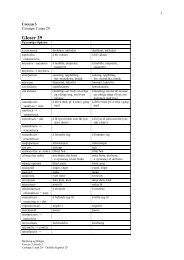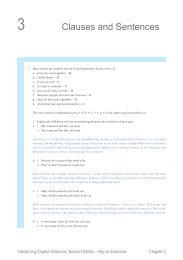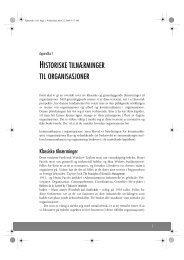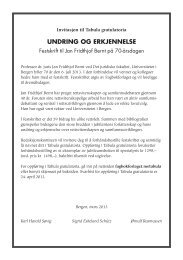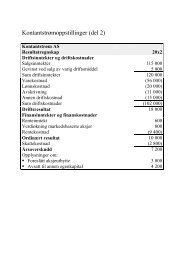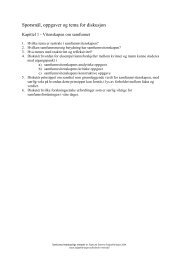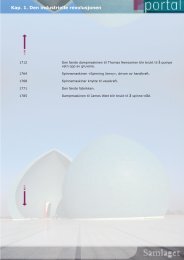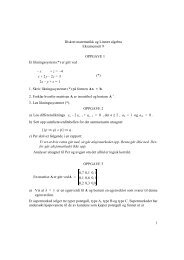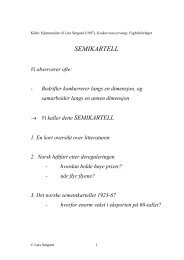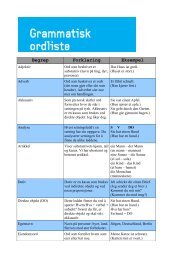Construct validation of a self-report psychopathy ... - Fagbokforlaget
Construct validation of a self-report psychopathy ... - Fagbokforlaget
Construct validation of a self-report psychopathy ... - Fagbokforlaget
Create successful ePaper yourself
Turn your PDF publications into a flip-book with our unique Google optimized e-Paper software.
Personality and Individual Differences 31 2001) 1021±1038<br />
www.elsevier.com/locate/paid<br />
<strong>Construct</strong> <strong>validation</strong> <strong>of</strong> a <strong>self</strong>-<strong>report</strong> <strong>psychopathy</strong> scale:<br />
does Levenson's <strong>self</strong>-<strong>report</strong> <strong>psychopathy</strong> scale measure the<br />
same constructs as Hare's <strong>psychopathy</strong> checklist-revised?<br />
Chad A. Brinkley a, *, William A. Schmitt a , Steven S. Smith b ,<br />
Joseph P. Newman a<br />
a Department <strong>of</strong> Psychology, University <strong>of</strong> Wisconsin, Madison, USA<br />
b Department <strong>of</strong> Medicine, University <strong>of</strong> Wisconsin, Madison, USA<br />
Received 17 September 1999; received in revised form 28 August 2000; accepted 28 September 2000<br />
Abstract<br />
In an e€ort to validate Levenson, Kiehl and Fitzpatrick's [Levenson, M. R., Kiehl, K. A., & Fitzpatrick,<br />
C. M. 1995). Assessing psychopathic attributes in a noninstitutionalized population. Journal <strong>of</strong> Personality<br />
and Social Psychology, 68, 151±158]. Self-<strong>report</strong> Psychopathy Scale SRPS) we compared it to Hare's<br />
[Hare, R. D. 1991). The Hare Psychopathy Checklist-Revised. Toronto: Multi-Health Systems] PCL-R)<br />
and examined its relation to criminal activity and a passive avoidance task. Participants were 270 Caucasian<br />
and 279 African-American participants in a minimum security state prison. Con®rmatory factor analysis<br />
provided modest support for the original SRPS factor structure. Although diagnostic concordance <strong>of</strong> the<br />
two instruments ranged from poor to fair, the SRPS and the PCL-R were signi®cantly correlated and both<br />
showed similar patterns <strong>of</strong> correlations to measures <strong>of</strong> substance abuse and criminal versatility. Both<br />
measures were also predictive <strong>of</strong> performance on a passive avoidance task. While this constellation <strong>of</strong><br />
®ndings provides some evidence for the construct validity <strong>of</strong> the SRPS, it also suggests that the SRPS may<br />
not measure the same construct as the PCL-R and further re®nement <strong>of</strong> the instrument appears to be<br />
warranted. # 2001 Elsevier Science Ltd. All rights reserved.<br />
Keywords: <strong>Construct</strong> <strong>validation</strong>; Criminal activity; Passive avoidance<br />
Psychopathy refers to a disorder that begins early in life and is characterized by a variety <strong>of</strong><br />
antisocial behaviors and exploitative interpersonal relationships. Prototypical psychopathic traits<br />
include callous and manipulative use <strong>of</strong> others, shallow and short-lived a€ect, irresponsible/<br />
impulsive behavior, egocentricity, and pathological lying Cleckley, 1976). Although this description<br />
includes both personality and behavioral characteristics, recent attempts to operationalize<br />
* *Corresponding author.<br />
E-mail address: brinkly@students.wisc.edu C.A. Brinkley)<br />
0191-8869/01/$ - see front matter # 2001 Elsevier Science Ltd. All rights reserved.<br />
PII: S0191-886900)00178-1
1022 C.A. Brinkley et al. / Personality and Individual Di€erences 31 2001) 1021±1038<br />
the <strong>psychopathy</strong> construct Ð such as the DSM-IV APA, 1994) Antisocial Personality Disorder<br />
APD) diagnosis Ð have focused on criminal behaviors as criteria for diagnostic purposes Hare,<br />
1985a, 1996; Lilienfeld, 1994; Millon, 1981). Researchers dissatis®ed with the APD criteria believe<br />
that personality features integral to the <strong>psychopathy</strong> construct are currently underrepresented by<br />
DSM diagnostic criteria Hare, 1985b). Hare 1996), for example, cites work demonstrating that<br />
the APD diagnosis identi®es a more heterogeneous group than do assessments based on inferred<br />
prototypical psychopathic traits.<br />
Trait-based assessments <strong>of</strong> <strong>psychopathy</strong> have been derived almost entirely from the work <strong>of</strong><br />
Cleckley 1976). Using his wealth <strong>of</strong> clinical experience as a guide, Cleckley was able to extract<br />
commonalties from numerous exemplar case studies to de®ne general features which he felt represented<br />
the core <strong>of</strong> the <strong>psychopathy</strong> construct. Often referred to as the Cleckley criteria, these 16<br />
features included such behaviors as failure to learn from experience and persistent lying as well as<br />
personality components such as callousness and egocentricity. Such traits, Cleckley argued, were<br />
prototypically psychopathic and might serve as markers for identifying those with the disorder.<br />
Although Cleckley's e€orts were entirely descriptive and he never presented a formal diagnostic<br />
system, he laid the groundwork for future e€orts to de®ne <strong>psychopathy</strong> as a construct capable <strong>of</strong><br />
reliable identi®cation.<br />
Hare 1980, 1991) took up where Cleckley left o€. Concerned that progress in the ®eld was being<br />
hampered by the lack <strong>of</strong> a sound psychometric instrument for the reliable and valid assessment <strong>of</strong><br />
<strong>psychopathy</strong>, Hare sought to transform the Cleckley criteria into a reliable diagnostic instrument.<br />
The result was the initial Psychopathy Checklist PCL) and its revision, the Psychopathy Checklist-<br />
Revised PCL-R). Both versions <strong>of</strong> the checklist were multi-item scales rated on the basis <strong>of</strong> personal<br />
interviews and corroborating information. Items were constructed based on the initial<br />
Cleckley criteria, although some were modi®ed so as to be more clearly assessed. Since its publication,<br />
the PCL-R Hare, 1991) has been a widely used measure and has been shown to have excellent<br />
psychometric properties in a variety <strong>of</strong> incarcerated populations Hare, 1996). Moreover, the<br />
development <strong>of</strong> the PCL-R as a standardized diagnostic tool has provided the foundation for a<br />
deluge <strong>of</strong> much-needed experimental work investigating the nature <strong>of</strong> the <strong>psychopathy</strong> construct.<br />
Many intriguing ®ndings about PCL-R de®ned psychopaths have emerged in the last decade.<br />
Among these are studies demonstrating that psychopaths display poor passive avoidance learning<br />
Newman & Kosson, 1986; Newman, Patterson, Howland & Nichols, 1990; Thornquist &<br />
Zuckerman, 1995), less di€erentiated emotional responses to a€ective stimuli Patrick, 1994),<br />
smaller skin conductance responses to fearful or distressing stimuli Blair, Jones, Clark & Smith,<br />
1997; Hare, 1978; Oglo€ & Wong, 1990), and di culties processing or producing emotional language<br />
Day & Wong, 1996; Hare, Williamson & Harpur, 1988). Such ®ndings have increased<br />
understanding <strong>of</strong> psychopathic behavior and helped to generate hypotheses about the etiology <strong>of</strong><br />
<strong>psychopathy</strong> for a review, see Hare, 1996).<br />
Although this work has been important to advancing the ®eld <strong>of</strong> <strong>psychopathy</strong>, it does have a<br />
major limitation. Almost without exception, all <strong>of</strong> these ®ndings have been obtained using participants<br />
from penal institutions. Many people feel that <strong>psychopathy</strong> necessarily implies criminal<br />
activity, but Cleckley 1976) clearly believed it did not. The di€erent case studies Cleckley presented<br />
were representative <strong>of</strong> a surprisingly large cross-section <strong>of</strong> the population. These individuals were<br />
from every social class, both genders, and di€erent ethnic backgrounds. The doctors, lawyers,<br />
and dilettantes described by Cleckley were a far cry from the criminals more commonly discussed
C.A. Brinkley et al. / Personality and Individual Di€erences 31 2001) 1021±1038 1023<br />
in the literature <strong>of</strong> today. Essentially, Cleckley made the case that <strong>psychopathy</strong> could, and did,<br />
exist in the population as a whole and did not necessarily involve criminal activity.<br />
If this is the case, why is it that most work with psychopaths has been done in a prison setting?<br />
There appear to be at least two reasons. First, when one is attempting to diagnose individuals<br />
well known for their deceitfulness, it is unwise to base diagnoses only on <strong>self</strong>-<strong>report</strong> interview<br />
information. Prisons maintain institutional ®les which can serve to corroborate or refute an<br />
inmate's interview information. Second, <strong>psychopathy</strong> is relatively infrequent in the population as<br />
a whole Hare, 1991). An e cient way to obtain a large number <strong>of</strong> participants for study is to<br />
sample from institutions where poorly socialized behavior is the norm Ð prisons.<br />
Despite these valid reasons for conducting research in a correctional setting, such a sampling<br />
strategy restricts the focus <strong>of</strong> <strong>psychopathy</strong> research to a relatively narrow group <strong>of</strong> criminal psychopaths.<br />
Any ®ndings based on prison samples must be regarded as tentative because they may be<br />
true <strong>of</strong> only the subset <strong>of</strong> institutionalized psychopaths Widom, 1977). In order to fully understand<br />
the construct <strong>of</strong> <strong>psychopathy</strong> as conceptualized by Cleckley 1976), we must also look at noninstitutionalized<br />
individuals. To do this successfully will require an instrument which measures<br />
the Cleckley/Hare <strong>psychopathy</strong> construct and which can be e ciently administered to a large<br />
community sample to identify enough psychopaths to conduct meaningful experimental studies.<br />
To date, e€orts to produce such instruments have been unable to address both <strong>of</strong> these concerns.<br />
Hart, Cox and Hare 1995) derived a measure from the PCL-R for use with community samples,<br />
the Psychopathy Checklist- Screening Version PCL-SV). The PCL-SV is, however, still interview<br />
based and, thus, expensive to administer to large groups <strong>of</strong> participants. To overcome this problem,<br />
researchers have used pen and paper assessments such as the psychopathic deviate Pd) scale <strong>of</strong> the<br />
Minnesota Multiphasic Personality Inventory MMPI) and the socialization scale So) <strong>of</strong> the California<br />
Psychological Inventory CPI; Gough, 1969). Unfortunately, these scales appear to be better<br />
measures <strong>of</strong> antisocial behavior than psychopathic personality and, thus, capture only part <strong>of</strong> the<br />
<strong>psychopathy</strong> construct Hare, 1991, 1996). A more sophisticated <strong>self</strong>-<strong>report</strong> instrument, the Psychopathy<br />
Personality Inventory PPI; Lilienfeld & Andrews, 1996), has been developed but there<br />
is still limited data examining how this measure relates to the <strong>psychopathy</strong> construct as de®ned by<br />
the PCL-R Poythress, Edens & Lilienfeld, 1998). 1 Thus researchers are still in need <strong>of</strong> a valid<br />
measure <strong>of</strong> <strong>psychopathy</strong> which is also easy, quick, and inexpensive to administer.<br />
Levenson et al. 1995) attempted to develop such a scale. The <strong>self</strong>-<strong>report</strong> <strong>psychopathy</strong> scale<br />
SRPS) is a pen and paper measure <strong>of</strong> <strong>psychopathy</strong> based on the PCL-R criteria and designed for<br />
use in college samples. The SRPS consists <strong>of</strong> 26 items divided into two separate scales Ð primary<br />
and secondary <strong>psychopathy</strong>. These scales correspond roughly to the two factors <strong>of</strong> the PCL-R. The<br />
primary <strong>psychopathy</strong> scale was designed to ``assess a sel®sh, uncaring, and manipulative posture<br />
towards others'' p.152) while the secondary <strong>psychopathy</strong> scale was created to ``assess impulsivity<br />
and a <strong>self</strong> defeating life style'' p. 152; Levenson et al.). Instead <strong>of</strong> emphasizing criminal activity, the<br />
SRPS was designed to elicit information about behaviors more typical <strong>of</strong> community life. For<br />
example, the individual's integrity is assessed by items such as ``even if I were trying hard to sell a<br />
product I would not lie about it'' p. 153; Levenson et al.).<br />
1 The authors would have liked to include the PPI in the current study so that we could 1) cross validate the measure<br />
and 2) compare it directly to both the PCL-R and the SRPS. Unfortunately, Lilienfeld and Andrews 1996) article<br />
had not yet been published when the data for the current study were being collected.
1024 C.A. Brinkley et al. / Personality and Individual Di€erences 31 2001) 1021±1038<br />
Levenson et al. 1995) sought to validate the measure in two ways. First, they examined the<br />
instrument's correlations with various <strong>self</strong>-<strong>report</strong> scales measuring constructs such as harm avoidance,<br />
boredom susceptibility, and thrill/adventure seeking to determine if they were <strong>of</strong> the direction<br />
and magnitude that would be expected for a measure <strong>of</strong> the <strong>psychopathy</strong> construct. Second, they<br />
tried to determine if high scores on the SRPS were predictive <strong>of</strong> various antisocial behaviors within<br />
a college environment such as cheating on exams, plagiarism, and drunk and disorderly behavior<br />
i.e. academic disciplinary problems). Levenson et al. 1995) found that SRPS scores were correlated<br />
as expected with other measures <strong>of</strong> personality. SRPS scores were also found to be a signi®cant<br />
predictor <strong>of</strong> academic disciplinary problems. Lynam, Whiteside and Jones 1999) recently<br />
conducted a cross <strong>validation</strong> study in which they replicated the SRPS' factor structure and relation<br />
to antisocial acts. They also demonstrated that SRPS scores were capable <strong>of</strong> predicting poor<br />
passive avoidance in a college sample Lynam et al., 1999).<br />
Although these data provide preliminary evidence concerning the validity <strong>of</strong> the SRPS as a<br />
measure <strong>of</strong> <strong>psychopathy</strong>, there is still an important piece <strong>of</strong> evidence which needs to be collected<br />
before we can conclude that this is the case. First, neither Levenson et al. 1995) nor Lynam et al.<br />
1999) made use <strong>of</strong> the PCL-R in their <strong>validation</strong> studies. It, therefore, remains to be seen if the<br />
SRPS measures a comparable construct to that tapped by the present ``gold standard'' <strong>of</strong> <strong>psychopathy</strong><br />
assessment. Thus, the next step in the <strong>validation</strong> <strong>of</strong> the SRPS as a measure for <strong>psychopathy</strong><br />
would seem to require comparing the SRPS with the PCL-R.<br />
Despite the fact that the SRPS was intended for noninstitutionalized populations, we believe<br />
this can be best accomplished in a prison sample. There are two reasons for this. First, almost all<br />
work validating the PCL-R has been done in a prison setting. Second, if the SRPS assesses the<br />
kind <strong>of</strong> impulsive, sel®sh, and callous presentation which we would expect from anyone meeting<br />
the Cleckley criteria institutionalized or not), it should be a valid indicator <strong>of</strong> <strong>psychopathy</strong> even<br />
in a prison population.<br />
In an attempt to cross-validate the SRPS in a prison population and determine if the SRPS<br />
measures the same construct as the PCL-R, we gathered data from a minimum security prison in<br />
Wisconsin in four di€erent <strong>validation</strong> domains. In particular, we investigated 1) the SRPS's factor<br />
structure and internal consistency, 2) the association <strong>of</strong> the SRPS with the PCL-R, 3) the similarity<br />
<strong>of</strong> the SRPS's and PCL-R's relationships to criminal activity and substance abuse, and 4) the<br />
relation between SRPS scores and performance on a laboratory measure <strong>of</strong> passive avoidance. If<br />
the SRPS can be shown to have the expected relations to important elements <strong>of</strong> <strong>psychopathy</strong>'s<br />
nomological net i.e. PCL-R scores, substance abuse, passive avoidance de®cits, etc.), then we will<br />
have taken some important steps towards validating an easily administered, pen and paper measure<br />
<strong>of</strong> <strong>psychopathy</strong>.<br />
1. Methods<br />
1.1. Participants<br />
The sample consisted <strong>of</strong> 279 African-American and 270 Caucasian male inmates from Wisconsin<br />
state prisons. Participants were obtained from a comprehensive roster after screening out<br />
those men who were above the age <strong>of</strong> 40, receiving psychotropic medication, diagnosed as having
schizophrenia or bipolar disorder, or noted as having reading and/or math skills below the fourth<br />
grade level as measured by the prison's standardized measures). All participants were told that<br />
their decision to take part in the current project or to refuse would have no in¯uence on their<br />
status within the correctional system. Informed consent was obtained from all participants.<br />
Participants who consented to take part in the study were then evaluated using the Psychopathy<br />
Checklist Revised PCL-R) and were asked to complete an extensive battery <strong>of</strong> <strong>self</strong>-<strong>report</strong> instruments<br />
over three separate days. Not all participants elected to complete all three days <strong>of</strong> the study.<br />
Data on personality measures administered on days two and three <strong>of</strong> the study were not available for<br />
all participants and, as a result, the sample sizes for the di€erent questionnaires vary.<br />
The measures administered included the Welsh Anxiety Scale WAS; Welsh, 1956), Short Form<br />
<strong>of</strong> the Michigan Alcohol Screening Test SMAST; Selzer, Vinokur & von Rooijen, 1975), the<br />
Shipley Institute <strong>of</strong> Living Scale SILS; Zachary, 1986), and the Self-<strong>report</strong> Psychopathy Scale<br />
SRPS; Levenson et al., 1995). 2 In addition, we obtained a measure <strong>of</strong> criminal versatility from<br />
the o cial records in their institutional ®les. Participants scoring below 70 on the estimated WAIS-<br />
R IQ from the SILS were eliminated from all analyses in this study because the authors believed<br />
these participants might have di culties understanding task and questionnaire instructions and<br />
content well enough to complete the necessary test battery.<br />
1.2. Assessment measures<br />
C.A. Brinkley et al. / Personality and Individual Di€erences 31 2001) 1021±1038 1025<br />
The Self-<strong>report</strong> Psychopathy Scale SRPS; Levenson et al., 1995) is a 26-item <strong>self</strong>-<strong>report</strong> measure<br />
designed to evaluate both the behavioral and personality traits commonly associated with<br />
<strong>psychopathy</strong> in the literature. Each item consists <strong>of</strong> a statement which the participant reads and<br />
then endorses on a four point scale ``disagree strongly'', ``disagree somewhat'', ``agree somewhat'',<br />
and ``agree strongly''). Some items are reversed in order to control for response sets.<br />
A factor analysis based on initial data collected by Levenson et al. 1995) using university<br />
undergraduates revealed two distinct factors. The ®rst factor, primary <strong>psychopathy</strong>, appears to<br />
measure a callous/manipulative interpersonal style whereas the second factor, secondary <strong>psychopathy</strong>,<br />
contains items related to behavioral problems such as poor behavioral controls, failure<br />
to learn from mistakes, etc.). These factors correspond roughly to the two factors <strong>of</strong> the PCL-<br />
R Harpur, Hare & Hakistan, 1989).<br />
Following the example <strong>of</strong> the PCL-R, participants were divided into three groups based on<br />
their total SRPS score. Those participants scoring in the top third <strong>of</strong> the distribution were considered<br />
psychopathic scores <strong>of</strong> 58 or more), those scoring in the lowest third <strong>of</strong> the distribution<br />
were considered nonpsychopathic scores <strong>of</strong> 48 and below), and those scoring in the middle were<br />
considered a mixed group scores <strong>of</strong> 49±57) according to the SRPS. Receiver Operating Curve<br />
ROC) analyses con®rmed that these cut o€ scores were optimal for balancing the SRPS's sensitivity<br />
and speci®city for identifying PCL-R de®ned psychopathic characteristics in participants.<br />
Descriptive statistics for the SRPS can be found in Table 1.<br />
2 Some readers may wonder why we did not make use <strong>of</strong> the <strong>self</strong> <strong>report</strong> measure derived from the PCL-R Ð Hare's<br />
<strong>self</strong> <strong>report</strong> <strong>psychopathy</strong> scale revised SRP-II; Hare, 1980). Our reasoning was that the SRP-II was created as an analog<br />
<strong>of</strong> the PCL-R and has high correlations with that instrument. Since we were using the PCL-R it<strong>self</strong>, there seemed little<br />
reason to include the SRP-II.
1026 C.A. Brinkley et al. / Personality and Individual Di€erences 31 2001) 1021±1038<br />
Table 1<br />
Summary statistics for the PCL-R and the SRPS a<br />
n PCL-R PCL-R PCL-R SRPS SRPS SRPS<br />
Total Factor 1 Factor 2 Total Primary Secondary<br />
M S.D.) M S.D.) MS.D.) MS.D.) MS.D.) MS.D.)<br />
Total sample 549 23.33 7.34) 8.99 3.43) 10.83 3.55) 54.66 11.58) 32.99 8.19) 21.68 5.05)<br />
Caucasian sample 270 23.29 7.47) 8.89 3.57) 11.00 3.57) 54.07 11.99) 31.86 8.22) 22.20 5.18)<br />
African-American sample 279 23.37 7.22) 9.10 3.29) 10.66 3.52) 55.24 11.16) 34.08 8.02) 21.17 4.87)<br />
a PCL-R, Psychopathy Checklist-Revised; SRPS, Self Report Psychopathy Scale; n, sample size; M, mean; S.D.,<br />
standard deviation<br />
The Psychopathy Checklist Revised PCL-R; Hare, 1991) is a checklist consisting <strong>of</strong> 20 items, each<br />
indicative <strong>of</strong> a core psychopathic attribute discussed by Cleckley 1976). Each item is rated from 0 to<br />
2, with 0 meaning the item isn't at all present and 2 indicating that it is certainly present, on the basis<br />
<strong>of</strong> an extensive interview and institutional ®le review. Scores on the PCL-R range from 0 to 40 with<br />
scores <strong>of</strong> 30 or more generally regarded as being indicative <strong>of</strong> <strong>psychopathy</strong> and scores <strong>of</strong> 20 or<br />
less generally being indicative <strong>of</strong> a distinct absence <strong>of</strong> <strong>psychopathy</strong>. The PCL-R has been shown<br />
to have a replicable two factor structure with factor 1 measuring a callous/manipulative interpersonal<br />
style and factor 2 measuring antisocial action Harpur, Hare & Hakstian, 1989). To<br />
date, a large body <strong>of</strong> evidence has accumulated indicating the instrument's reliability and validity<br />
for use with Caucasian, male, o€enders Hare, 1996). Preliminary evidence for the reliability and<br />
validity <strong>of</strong> the PCL and PCL-R in African American male o€enders has been <strong>report</strong>ed by Kosson,<br />
Smith and Newman 1990) and Lorenz, Smith, Bolt, Schmitt and Newman 2000). Descriptive<br />
statistics for the PCL-R can be found in Table 1.<br />
Given that the PCL-R and the SRPS are both <strong>report</strong>ed to be measures <strong>of</strong> the <strong>psychopathy</strong><br />
construct, we hypothesized that the two would be highly correlated. Further, we expected factor 1<br />
<strong>of</strong> the PCL-R to be more strongly correlated with primary <strong>psychopathy</strong> factor 1) <strong>of</strong> the SRPS<br />
and factor 2 <strong>of</strong> the PCL-R to be more strongly correlated with secondary <strong>psychopathy</strong> factor 2)<br />
<strong>of</strong> the SRPS.<br />
The Short Form <strong>of</strong> the Michigan Alcohol Screening Test SMAST; Selzer et al., 1975) is a<br />
questionnaire consisting <strong>of</strong> 34 yes±no items concerning the symptoms and consequences <strong>of</strong> alcohol<br />
abuse and dependence. Scores on the SMAST have been shown to di€erentiate alcoholics from<br />
controls Hedlund & Viewig, 1984). SMAST scores have also been <strong>report</strong>ed to correlate highly with<br />
both the full version <strong>of</strong> the Michigan Alcohol Screening Test Selzer et al.) and other <strong>self</strong>-<strong>report</strong><br />
measures <strong>of</strong> alcohol abuse/dependence Hedlund & Viewig).<br />
Hart and Hare 1989) have <strong>report</strong>ed that psychopaths have signi®cant substance abuse problems.<br />
Smith and Newman 1990) have demonstrated that lifetime DSM-III diagnoses <strong>of</strong> alcoholism<br />
are signi®cantly correlated with the total and factor 2 scores, but not factor 1 scores, <strong>of</strong><br />
the PCL-R. Based on this evidence, the authors predicted that scores on the SMAST would be<br />
signi®cantly correlated with total and factor 2 scores, but not factor 1 scores, for both the PCL-R<br />
and the SRPS.<br />
The Welsh Anxiety Scale WAS; Welsh, 1956) is a 39-item questionnaire, derived from the<br />
MMPI, designed to measure anxiety. The WAS is not, however, a ``pure'' measure <strong>of</strong> anxiety and
elates not only to measures <strong>of</strong> anxiety, but also depression and negative a€ect. Gray 1991) has,<br />
in fact, suggested that the ``anxiety'' construct measured by the WAS is actually a hybrid <strong>of</strong> two<br />
parts neuroticism and one part introversion that corresponds to his behavioral inhibition construct.<br />
The Shipley Institute <strong>of</strong> Living Scale SILS; Zachary, 1986) is a brief measure <strong>of</strong> general intellectual<br />
functioning. It consists <strong>of</strong> a 40-item vocabulary test and a 20-item abstraction test. This<br />
test has demonstrated good psychometric properties and the revised scoring procedures make it<br />
possible to obtain reliable estimates <strong>of</strong> Wechsler Adult Intelligence Scale Ð Revised WAIS-R)<br />
scores Zachary, 1986). The SILS was used as a screening measure in this study.<br />
Criminal versatility was determined by reviewing inmate ®les and counting the total number <strong>of</strong><br />
di€erent types <strong>of</strong> crimes committed. The categories used to di€erentiate crimes were those<br />
described in the PCL-R manual Hare, 1991). Crimes were coded as violent if they involved<br />
murder, battery, assault, sexual crimes or weapons charges. All other crimes were considered<br />
nonviolent. Because this measure <strong>of</strong> criminal versatility is identical to that used to code item 20 <strong>of</strong><br />
the PCL-R, correlations between the PCL-R and criminal versatility were done using a prorated<br />
version <strong>of</strong> the participants' PCL-R scores which omitted item 20. As criminal versatility is theoretically<br />
related to the <strong>psychopathy</strong> construct Hare, 1991), the authors hypothesized that it<br />
would be signi®cantly related to both PCL-R and SRPS scores.<br />
1.3. Passive avoidance task<br />
C.A. Brinkley et al. / Personality and Individual Di€erences 31 2001) 1021±1038 1027<br />
The experimental task used in this study was a version <strong>of</strong> the passive avoidance task developed<br />
by Newman and Kosson 1986). This task was selected because poor passive avoidance performance<br />
is one <strong>of</strong> the most replicable ®ndings in the <strong>psychopathy</strong> literature Lykken, 1995; Newman<br />
& Kosson, 1986; Newman & Schmitt, 1998; Newman et al., 1990) and Lynam et al. 1999)<br />
have found that SRPS scores predict performance on this task in a college sample. The task was<br />
conducted using an IBM compatible computer, a standard 13 inch monitor, and a black plastic<br />
response box with one push button located on the top. At the beginning <strong>of</strong> the task, participants<br />
received instructions indicating that they would be seeing a series <strong>of</strong> 10 numbers many di€erent<br />
times and in random orders. They were informed that some <strong>of</strong> these numbers would be ``good''<br />
numbers S+'s) and some <strong>of</strong> them would be ``bad'' numbers S 's). To maximize their earnings,<br />
participants were told to push the button whenever they saw an S+ and not push the button<br />
whenever they saw an S . The stimuli for the task consisted <strong>of</strong> 10 di€erent numbers between 01<br />
and 99. These numbers were divided into two separate lists counterbalanced for the attributes <strong>of</strong><br />
being below or above 50 and being either even or odd. Furthermore, the list which served as the<br />
S+'s for one half <strong>of</strong> the participants served as the S-'s for the other half. Each number was presented<br />
in white on a black background for 2.5 seconds and measured 5.1 2.5 cm. Prior to<br />
receiving the 90 test trials which consisted <strong>of</strong> nine blocks <strong>of</strong> 10 trials each, participants received a<br />
®ve trial pretreatment which included each <strong>of</strong> the ®ve S+'s. The purpose <strong>of</strong> the pretreatment was<br />
to encourage a dominant response set for reward. Other than the ®rst ®ve trials, the numbers<br />
appeared randomly on the screen with the stipulation that no more than three S+'s or three S-'s<br />
would occur in a row. Each time the participants pressed the button when an S+ was present,<br />
they were reinforced by the presentation <strong>of</strong> a high-pitched tone, a message that they had won 10<br />
cents, and a poker chip representing their reward. Each time the participants pressed the button
1028 C.A. Brinkley et al. / Personality and Individual Di€erences 31 2001) 1021±1038<br />
when an S was present, they received feedback consisting <strong>of</strong> the presentation <strong>of</strong> a low-pitched<br />
tone, a message that they had lost 10 cents, and the removal <strong>of</strong> a poker chip. No rewards or<br />
punishments were administered in the absence <strong>of</strong> a response.<br />
Performance on the passive avoidance task is evaluated by looking at two di€erent types <strong>of</strong><br />
errors. Commission errors are de®ned as failures to inhibit responses to S stimuli and omission<br />
errors are de®ned as failures to respond to S+ stimuli. Errors <strong>of</strong> commission represent failures <strong>of</strong><br />
passive avoidance and have di€erentiated PCL-R de®ned psychopaths and controls in past<br />
research. As the task requires that participants observe all stimuli before performance can re¯ect<br />
learning, data from the ®rst block <strong>of</strong> trials are not analyzed. Following Newman and Schmitt<br />
1998) and Lynam et al. 1999), it was hypothesized that low-anxious psychopaths de®ned using<br />
either the PCL-R or the SRPS) would make more commission errors than low-anxious controls.<br />
Although some <strong>of</strong> the passive avoidance data has been previously presented in Newman and<br />
Schmitt 1998), we felt the comparisons between the performances <strong>of</strong> SRPS and PCL-R de®ned<br />
psychopaths and controls on this task was su ciently interesting and important to warrant<br />
<strong>report</strong>ing the data here as well. It should be noted that the data sets for the two papers are slightly<br />
di€erent because participants included in Newman and Schmitt's study who did not have SRPS<br />
scores were excluded from the present analyses.<br />
2. Results<br />
2.1. Con®rmatory factor analyses<br />
Con®rmatory factor analyses CFAs) were conducted to determine the adequacy <strong>of</strong> ®t <strong>of</strong> a<br />
two-factor model for the SRPS as identi®ed by Levenson et al. 1995). For the two-factor model,<br />
each item was constrained to load on only one <strong>of</strong> the two factors 16 items loading on the SRPS<br />
primary scale and 10 items loading on the SRPS secondary scale) and latent factors were allowed to<br />
correlate. Fit indices used to determine goodness-<strong>of</strong>-®t included the comparative ®t index CFI;<br />
Bentler, 1990), the root mean square error <strong>of</strong> approximation RMSEA; Browne & Cudeck, 1993),<br />
and the Bentler and Bonett 1980) non-normed ®t index NNFI). Values for CFI and NNFI above<br />
0.9 are indicative <strong>of</strong> good ®t; an RMSEA value <strong>of</strong> 0.05 or smaller is indicative <strong>of</strong> good ®t whereas<br />
RMSEA values between 0.05 and 0.08 indicate a reasonable model ®t Browne & Cudeck, 1993).<br />
Model improvements were tested by means <strong>of</strong> change in model chi-square w 2 ).<br />
In order to test the comparability <strong>of</strong> the SRPS item-factor relations across the Caucasian and<br />
African-American samples, two-factor CFA invariance models were ®t to the data. Prior to<br />
invariance modeling, the ®t <strong>of</strong> the Levenson et al. 1995) two-factor model was examined for each<br />
race separately to establish good-®tting baseline models Byrne, 1994). When Lynam et al. 1999)<br />
conducted two-factor CFAs <strong>of</strong> the SRPS using data from college undergraduates, model ®t was<br />
found to be poor unless several errors <strong>of</strong> measurement were allowed to correlate and one item<br />
was allowed to load on both factors ``Love is overrated``).<br />
In the current study, initial two-factor CFAs were computed without specifying the Lynam et al.<br />
1999) model modi®cations correlated errors and one item loading on both factors) and these analyses<br />
revealed poor model ®t for both Caucasians CFI=0.85, NNFI=0.83, RMSEA=0.06) and<br />
African-Americans CFI=0.79, NNFI=0.77, RMSEA=0.08). Adding the model modi®cations
identi®ed by Lynam et al. 1999) signi®cantly improved model ®t for both Caucasians<br />
CFI=0.90, NNFI=0.88, RMSEA=0.05; w 2 df=18)=90.95, P
1030 C.A. Brinkley et al. / Personality and Individual Di€erences 31 2001) 1021±1038<br />
R and the PCL-R total score in Caucasians, African-Americans and the total sample. Scores on<br />
the SRPS secondary scale were signi®cantly correlated with PCL-R factor 2 and total scores in all<br />
three samples, and were signi®cantly correlated with PCL-R factor 1 in the total and Caucasian,<br />
but not African-American, samples. A concise listing <strong>of</strong> means and standard deviations for the<br />
SRPS and PCL-R can be found in Table 1. Correlations between the SRPS and the PCL-R are<br />
<strong>report</strong>ed in Table 2.<br />
2.4. Relationship to criminal versatility and substance abuse<br />
To determine whether or not the behavioral correlates <strong>of</strong> the SRPS are the same as those <strong>of</strong> the<br />
PCL-R, we examined the similarity <strong>of</strong> the correlations between the two assessment devices and<br />
measures <strong>of</strong> criminal versatility and substance abuse SMAST). Prorated PCL-R total scores<br />
excluding item 20) were signi®cantly correlated with both violent and nonviolent criminal activity.<br />
SRPS total scores, however, were signi®cantly correlated with violent criminal activity, but<br />
not nonviolent criminal activity. This pattern was similar for both the Caucasian and African-<br />
American subsamples.<br />
The correlations between the PCL-R, SRPS, and the SMAST are particularly noteworthy. In the<br />
total sample, the PCL-R total and PCL-R factor 2 scores, but not PCL-R factor 1 scores, are signi®cantly<br />
correlated with SMAST scores. Similarly, SRPS total and secondary scores are signi®cantly<br />
correlated with SMAST scores, but SRPS primary scores are not. This pattern is the same in the<br />
Caucasian subsample. In the African-American subsample, the pattern is similar but the SRPS<br />
total score is not signi®cantly correlated with the SMAST scores. Correlations between the SRPS,<br />
PCL-R and clinical/behavioral outcome measures are <strong>report</strong>ed in Table 3.<br />
Table 2<br />
Correlations between the PCL-R and the SRPS a SRPS SRPS SRPS<br />
Total score Primary scale Secondary scale<br />
Total sample n= 549)<br />
PCL-R total 0.35*** 0.34*** 0.27***<br />
PCL-R factor 1 0.27*** 0.30*** 0.13**<br />
PCL-R factor 2 0.38*** 0.31*** 0.36***<br />
Caucasian subsample n= 270)<br />
PCL-R total 0.40*** 0.36*** 0.34***<br />
PCL-R factor 1 0.29*** 0.30*** 0.19**<br />
PCL-R factor 2 0.44*** 0.37*** 0.45***<br />
African-American subsample n= 279)<br />
PCL-R total 0.31*** 0.31*** 0.19***<br />
PCL-R factor 1 0.25*** 0.30*** 0.08<br />
PCL-R factor 2 0.31*** 0.28*** 0.26***<br />
a PCL-R=Psychopathy Checklist-Revised; SRPS=Self Report Psychopathy Scale. *P
Table 3<br />
PCL-R and SRPS correlations with criminal activity and substance abuse a<br />
n PCL-R PCL-R PCL-R SRPS SRPS SRPS<br />
Total Factor 1 Factor 2 Total Primary Secondary<br />
Total sample<br />
SMAST 543 0.19*** 0.04 0.27*** 0.18** 0.08 0.28***<br />
Criminal activity non-violent) 378 0.26*** 0.17*** 0.27*** 0.01 0.02 0.07<br />
Criminal activity violent) 378 0.30*** 0.24*** 0.28*** 0.24*** 0.25*** 0.14**<br />
Caucasian subsample<br />
SMAST 267 0.21*** 0.04 0.29*** 0.19** 0.12 0.25***<br />
Criminal activity non-violent) 197 0.30*** 0.17* 0.33*** 0.06 0.05 0.07<br />
Criminal activity violent) 197 0.24*** 0.21** 0.20** 0.18** 0.17* 0.14*<br />
African-American subsample<br />
SMAST 276 0.18** 0.06 0.25*** 0.20*** 0.11 0.28**<br />
Criminal activity non-violent) 181 0.21** 0.20** 0.17 0.04 0.04 0.02<br />
Criminal activity violent) 181 0.39*** 0.28*** 0.40*** 0.30*** 0.30*** 0.21*<br />
a PCL-R, Psychopathy Checklist-Revised; SRPS, Self Report Psychopathy Scale; SMAST, Short Form Michigan<br />
Alchohol Screening Test. Criminal activity was determined by counting the total number <strong>of</strong> crimes an individual had<br />
been charged with which were either violent or non-violent. Murder, attempted murder, assault, battery, weapons<br />
charges, and any crime involving a weapon were coded as violent crimes. All other kinds <strong>of</strong> charges were coded as nonviolent<br />
crimes. Correlations between criminal versatility and PCL-R total scores use a prorated PCL-R score which<br />
excludes item 20 Ð criminal versatility.<br />
P
1032 C.A. Brinkley et al. / Personality and Individual Di€erences 31 2001) 1021±1038<br />
Table 4<br />
Diagnostic concordance <strong>of</strong> the SRPS and the PCL-R using high, middle, and low scorers a<br />
High PCL-R Middle PCL-R Low PCL-R<br />
score 430; n) score 21±29; n) score 520; n)<br />
Caucasian subsample<br />
High SRPS score 458) 32 36 21<br />
Middle SRPS score 48±57) 20 35 27<br />
Low SRPS score 547) 7 28 39<br />
African-American subsample<br />
High SRPS score458) 29 45 22<br />
Middle SRPS score 48±57) 18 22 25<br />
Low SRPS score 547) 8 28 34<br />
Total sample<br />
High SRPS score 458) 61 81 43<br />
Middle SRPS score 48±57) 38 57 52<br />
Low SRPS score 547) 15 56 73<br />
a PCL-R, Psychopathy Checklist-Revised; SRPS, Self-Report Psychopathy Scale; n, number <strong>of</strong> participants.<br />
anxiety, low anxiety), and ethnic group Caucasian, African-American) were the between-participants<br />
variables and type <strong>of</strong> error passive avoidance, omission) was the within-participants<br />
variable. The second analysis used level <strong>of</strong> SRPS total scores high SRPS, low SRPS), level <strong>of</strong><br />
WAS scores high anxiety, low anxiety), and ethnic group Caucasian, African-American) as the<br />
between-participants variables and type <strong>of</strong> error passive avoidance, omission) was the withinparticipants<br />
variable. Two sets <strong>of</strong> planned comparisons, one for PCL-R data and one for SRPS<br />
data, were conducted using two-tailed t-tests to test the a priori hypothesis that low-anxious<br />
psychopaths commit more passive avoidance errors than do low-anxious controls.<br />
Examination <strong>of</strong> the PCL-R ANOVA revealed a signi®cant PsychopathyAnxiety interaction<br />
F 1, 79)=6.97, P
C.A. Brinkley et al. / Personality and Individual Di€erences 31 2001) 1021±1038 1033<br />
Examination <strong>of</strong> the SRPS ANOVA revealed a signi®cant e€ect for type <strong>of</strong> error F 1,<br />
85)=18.59, P
1034 C.A. Brinkley et al. / Personality and Individual Di€erences 31 2001) 1021±1038<br />
SRPS and the PCL-R provided preliminary evidence that the SRPS is, to some extent, measuring<br />
a similar or related construct as that underlying the PCL-R. It should be noted that the magnitude<br />
<strong>of</strong> these correlations was small to moderate and similar to those typically found between the<br />
PCL-R and other <strong>self</strong>-<strong>report</strong> measures <strong>of</strong> <strong>psychopathy</strong> such as the Pd and So scales) and the<br />
PCL-R Hare, 1991). These other measures, however, have typically been found only to correlate<br />
with PCL-R factor 2, whereas the SRPS was found to correlate with both factors <strong>of</strong> the PCL-R.<br />
In contrast to other <strong>self</strong>-<strong>report</strong> measures, the SRPS appears to tap the psychopathic personality<br />
as well as antisocial behavior.<br />
The PCL-R's relation to substance abuse and criminal versatility is well documented Hart &<br />
Hare, 1989). Smith and Newman 1990) have noted that substance abuse is signi®cantly and<br />
positively associated with PCL-R factor 2, but not factor 1. In the present study, scores on the<br />
SMAST were signi®cantly associated with PCL-R factor 2, but not factor 1 scores. Similarly, the<br />
secondary factor <strong>of</strong> the SRPS was signi®cantly correlated with SMAST scores, but the primary<br />
factor <strong>of</strong> the SRPS was not. The correspondence between the PCL-R's and SRPS' relation to a<br />
measure <strong>of</strong> alcohol abuse is further evidence that the constructs underlying these measures relate<br />
to key external criteria in similar ways.<br />
Williamson, Hare and Wong 1987) have also demonstrated that PCL-R ratings are positively<br />
related to violent criminal activity. In the present study, high PCL-R scores were signi®cantly<br />
associated with both violent and nonviolent criminal versatility. High SRPS scores were signi®cantly<br />
associated with violent, but not nonviolent, criminal versatility. Although it is promising<br />
that these two measures correspond in their relation to violent crimes, the di€erent relations<br />
between the PCL-R and the SRPS to nonviolent crimes could be seen as problematic. Future<br />
work is needed to clarify this discrepancy between the two measures.<br />
Diagnostic concordance results indicated poor agreement between the PCL-R and SRPS<br />
except when the SRPS is used to identify extreme groups. The magnitude <strong>of</strong> Kappa, however,<br />
when extreme groups are identi®ed 0.38 to 0.57) is still only fair to good using interpretive<br />
guidelines suggested by Landis and Koch 1977). Thus, the use <strong>of</strong> the SRPS to identify psychopaths<br />
and nonpsychopaths in incarcerated samples may introduce considerable measurement<br />
error.<br />
Previous work has demonstrated that PCL-R psychopaths are prone to making commission<br />
errors on passive avoidance tasks Newman & Kosson, 1986; Thornquist & Zuckerman, 1995). In<br />
the present study, ``psychopaths'' selected using the SRPS responded almost identically on the<br />
passive avoidance task to ``psychopaths'' selected using the PCL-R. The only di€erence was that<br />
PCL-R psychopaths' performance was signi®cantly in¯uenced by their WAS scores whereas<br />
SRPS psychopaths' performance was not. Although it is not entirely clear why WAS anxiety<br />
would in¯uence performance for groups de®ned using the PCL-R and not the SRPS, there are a<br />
number <strong>of</strong> possibilities. Possible explanations might include shared method variance between<br />
the WAS and the SRPS or true di€erences between the constructs measured by the SRPS and<br />
PCL-R.<br />
In summary, Levenson's SRPS has the predicted correlations with both factors <strong>of</strong> the PCL-R,<br />
and it demonstrates similar relationships to <strong>self</strong>-<strong>report</strong>ed measures <strong>of</strong> substance abuse and violent<br />
criminal versatility as does Hare's PCL-R. Further, high scores on the SRPS appear to predict<br />
errors on a passive avoidance task as does the PCL-R. Given that the PCL-R is currently the most<br />
widely accepted measure <strong>of</strong> the <strong>psychopathy</strong> construct, this preliminary evidence suggests that the
C.A. Brinkley et al. / Personality and Individual Di€erences 31 2001) 1021±1038 1035<br />
SRPS is a promising, albeit weaker, measure <strong>of</strong> a similar or related construct. This ®nding is<br />
particularly impressive when one considers that the present study, having used an institutional<br />
sample, favored the performance <strong>of</strong> the PCL-R and put the SRPS at a disadvantage.<br />
Despite this, the present evidence does not suggest that SRPS and the PCL-R are measuring<br />
precisely the same construct. Although signi®cant, the magnitude <strong>of</strong> the correlations between the<br />
PCL-R and the SRPS are small. Also, the diagnostic concordance between the PCL-R and the<br />
SRPS is fair at best, suggesting that the two would not identify precisely the same research<br />
participants for study. The present results also suggest that the two-factor structure <strong>report</strong>ed by<br />
Levenson et al. may be di€erent for Caucasians and African-Americans and, as such, the SRPS<br />
may not perform the same way in di€erent ethnic and racial populations. Finally, SRPS scores<br />
are only based on <strong>self</strong>-<strong>report</strong> data and do not make use <strong>of</strong> any kind <strong>of</strong> collateral information.<br />
As a result, the instrument is susceptible to ``faking good or bad'' response bias Hare, 1991,<br />
1996).<br />
Taking these limitations into consideration, however, the SRPS still has many potential bene-<br />
®ts for researchers. It is quick, easy, and inexpensive to administer and it has fair diagnostic<br />
concordance with PCL-R when extreme scores are used. Given how costly and time consuming it<br />
is to do full interviews with all members <strong>of</strong> a sample, the SRPS may also be a useful screening<br />
instrument for selecting key participants in studies making use <strong>of</strong> the PCL-R or PCL-SV. Also,<br />
the SRPS is one <strong>of</strong> the few <strong>self</strong>-<strong>report</strong> measures <strong>of</strong> <strong>psychopathy</strong> that seems to tap into personality<br />
as well as non-criminal antisocial behavior. In fact, the instrument it<strong>self</strong> has no questions pertaining<br />
directly to criminal activity. Therefore, researchers interested in studying <strong>psychopathy</strong><br />
who are limited by resources and must make use <strong>of</strong> simpli®ed <strong>self</strong>-<strong>report</strong> measures may ®nd the<br />
SRPS a preferable measure to the Pd or So scales which tap only the antisocial component <strong>of</strong><br />
<strong>psychopathy</strong>.<br />
We have three recommendations for future research with the SRPS. First, our ®ndings suggest<br />
that several <strong>of</strong> the items on SRPS do not perform well. Additional research is needed to identify<br />
individual SRPS items that do not contribute much to the overall measure as well as those items<br />
that show measurement non-invariance across important ethnic and racial groups. Psychometrically<br />
inadequate items should be replaced with better performing questions.<br />
Second, we need to conduct large-scale cross-<strong>validation</strong> studies in a variety <strong>of</strong> noninstitutionalized<br />
samples such as Lynam et al.'s 1999). Although the current <strong>validation</strong> study<br />
with the prison population was useful in order to compare the underlying constructs <strong>of</strong> the SRPS<br />
and the PCL-R, it does not directly address questions about how the SRPS performs with the<br />
intended population. Future <strong>validation</strong> studies should include individuals from the community at<br />
large such as university students, laborers, white collar workers, and the like. Such studies should<br />
also make use <strong>of</strong> con®rmatory factor analysis as well as a variety <strong>of</strong> <strong>self</strong>-<strong>report</strong> and behavioral<br />
measures. In this way the SRPS can be validated in a number <strong>of</strong> di€erent population samples and<br />
sampling domains.<br />
Finally, there is a need for more research comparing existing <strong>self</strong>-<strong>report</strong> measures <strong>of</strong> <strong>psychopathy</strong>.<br />
Given the time and energy necessary to validate such measures, it is in researchers' best<br />
interest to devote resources to perfecting our most promising scales. We need to determine<br />
appropriate uses for such scales and how well individual scales perform relative to one another.<br />
For this reason, future <strong>validation</strong> studies should include not only the SRPS, but also measures<br />
such as Hare's <strong>self</strong>-<strong>report</strong> scale SRP-II; Hare, 1990), and Lilienfeld and Andrews PPI 1996).
1036 C.A. Brinkley et al. / Personality and Individual Di€erences 31 2001) 1021±1038<br />
Table 5<br />
Passive avoidance and omission errors for PCL-R psychopaths and controls subdivided using Welsh anxiety a<br />
Group n Passive avoidance M S.D.) Omission M S.D.)<br />
Caucasian Subsample<br />
Low-WAS controls 13 14.23 6.42) 10.23 6.69)<br />
High-WAS controls 11 19.09 9.09) 12.45 7.48)<br />
Low-WAS psychopaths 10 21.10 7.09) 10.30 8.31)<br />
High-WAS psychopaths 11 16.09 8.41) 6.82 4.67)<br />
African-American subsample<br />
Low-WAS controls 15 16.27 9.59) 15.27 9.76)<br />
High-WAS controls 8 13.25 6.23) 15.50 10.22)<br />
Low-WAS psychopaths 6 21.33 6.62) 10.17 5.04)<br />
High-WAS psychopaths 13 14.69 8.41) 10.76 4.66)<br />
Total sample<br />
Low-WAS controls 28 15.32 8.19) 12.93 8.70)<br />
High-WAS controls 19 16.63 8.35) 13.74 8.61)<br />
Low-WAS psychopaths 16 21.19 6.70) 10.25 7.07)<br />
High-WAS psychopaths 24 15.33 9.25) 8.96 7.56)<br />
a PCL-R, Psychopathy Checklist-Revised; WAS, Welsh Anxiety Scale; n, sample size; M, mean; S.D., standard<br />
deviation<br />
Table 6<br />
Passive avoidance and omission errors for SRPS psychopaths and controls subdivided using Welsh anxiety a<br />
Group n Passive avoidance S.D.) Omission S.D.)<br />
Caucasian subsample<br />
Low-WAS controls 18 15.67 8.69) 10.83 5.80)<br />
High-WAS controls 2 16.50 2.12) 8.00 2.82)<br />
Low-WAS psychopaths 7 20.71 3.05) 7.43 2.52)<br />
High-WAS psychopaths 21 17.38 6.89) 7.48 3.51)<br />
African-American subsample<br />
Low-WAS controls 14 16.00 7.21) 15.00 9.87)<br />
High-WAS controls 3 10.67 3.06) 11.33 2.52)<br />
Low-WAS psychopaths 6 22.33 4.99) 8.50 5.62)<br />
High-WAS psychopaths 22 20.05 8.64) 11.73 6.51)<br />
Total Sample<br />
Low-WAS controls 32 15.81 7.95) 12.66 7.98)<br />
High-WAS controls 5 13.00 4.00) 10.00 2.92)<br />
Low-WAS psychopaths 13 21.46 5.74) 7.92 4.61)<br />
High-WAS psychopaths 43 18.74 7.89) 9.65 6.97)<br />
a SRPS, Self Report Psychopathy Scale, WAS=Welsh Anxiety Scale; n, sample size; M, mean; S.D., standard<br />
deviation
Acknowledgements<br />
C.A. Brinkley et al. / Personality and Individual Di€erences 31 2001) 1021±1038 1037<br />
The study was supported by a grant from the National Institute <strong>of</strong> Mental Health to Joseph P.<br />
Newman. The authors would like to thank the Department <strong>of</strong> Corrections and the sta€ <strong>of</strong> Oakhill<br />
Correctional Institution for their assistance with this research. We also wish to thank<br />
Amanda Lorenz and Jennifer Vitale for interviewing participants and collecting data as well as<br />
Michael Levenson for providing us with data for calculating our congruence coe cients.<br />
References<br />
American Psychiatry Association 1994). Diagnostic and statistical manual <strong>of</strong> mental disorder 4th ed.). Washington,<br />
DC: Author.<br />
Bentler, P. 1990). Comparative ®t indexes in structural models. Psychological Bulletin, 107, 238±246.<br />
Bentler, P., & Bonett, D. G. 1980). Signi®cance tests and goodness <strong>of</strong> ®t in the analysis <strong>of</strong> covariance structures.<br />
Psychological Bulletin, 88, 588±606.<br />
Blair, R. J. R., Jones, L., Clark, F., & Smith, M. 1997). The psychopathic individual: a lack <strong>of</strong> responsiveness to distress<br />
cues? Psychophysiology, 34, 192±198.<br />
Browne, M. W., & Cudeck, R. 1993). Alternative ways <strong>of</strong> assessing model ®t. In K. A. Bollen, & J. S. Long, Testing<br />
structural equation models pp. 136±162). Newbury Park, California: Sage.<br />
Byrne, B. M. 1994). Structural equation modeling with EQS and EQS/Windows: basic concepts, applications, and programming.<br />
Thousand Oaks, CA: Sage Publications.<br />
Cleckley, H. 1976). The mask <strong>of</strong> sanity 5th Ed.). St. Louis, MO: Mosby.<br />
Day, R., & Wong, S. 1996). Anomalous Perceptual asymmetries for negative emotional stimuli in the psychopath.<br />
Journal <strong>of</strong> Abnormal Psychology, 105, 648±652.<br />
Gough, H. G. 1969). Manual for the California psychological inventory Rev. Ed.). Palo Alto, Ca: Consulting Psychologists<br />
Press.<br />
Gray, J. A. 1991) Neural systems, emotion and personality. In J. Madden IV, Neurobiology <strong>of</strong> learning, emotion, and<br />
a€ect pp. 273±396). New York: Raven Press, Ltd.<br />
Hare, R. D. 1978). Psychopathy and electrodermal responses to nonsignal stimulation. Biological Psychology, 6, 237±246.<br />
Hare, R. D. 1980). A research scale for the assessment <strong>of</strong> <strong>psychopathy</strong> in criminal populations. Personality and Individual<br />
Di€erences, 1, 111±119.<br />
Hare, R. D. 1985a). Comparison <strong>of</strong> procedures for the assessment <strong>of</strong> <strong>psychopathy</strong>. Journal <strong>of</strong> Consulting and Clinical<br />
Psychology, 53, 7±16.<br />
Hare, R. D. 1985b). The <strong>psychopathy</strong> checklist. Unpublished manuscript. Vancouver, Canada: Department <strong>of</strong> Psychology,<br />
University <strong>of</strong> British Columbia.<br />
Hare, R.D. 1990). The Self-Report Psychopathy Scale- II. Unpublished test. Vancouver, Canada: Department <strong>of</strong><br />
psychology, University <strong>of</strong> British Columbia.<br />
Hare, R. D. 1991). The Hare Psychopathy Checklist-Revised. Toronto: Multi-Health Systems.<br />
Hare, R. D. 1996). Psychopathy: a clinical construct whose time has come. Criminal Justice and Behavior, 23, 25±54.<br />
Hare, R. D., Williamson, S. E., & Harpur, T. J. 1988). Psychopathy and Language. In T. E. Mo tt, & S. A. Mednick,<br />
Biological contributions to crime causation. Dordrecht, Netherlands: Nijho€ Martinus.<br />
Harpur, T. J., Hare, R. D., & Hakstian, A. R. 1989). Two-factor conceptualization <strong>of</strong> <strong>psychopathy</strong>: construct validity<br />
and assessment implications. Psychological Assessment: A Journal <strong>of</strong> Consulting and Clinical Psychology, 1, 6±17.<br />
Hart, S. D., Cox, D. N., & Hare, R. D. 1995). Manual for the Screening Version <strong>of</strong> the Hare Psychopathy Checklist-<br />
Revised PCL-R:SV). Toronto: Multihealth Systems.<br />
Hart, S. D., & Hare, R. D. 1989). Discriminant validity <strong>of</strong> the Psychopathy Checklist in a forensic psychiatric population.<br />
Psychological Assessment: A Journal <strong>of</strong> Consulting and Clinical Psychology, 1, 211±218.<br />
Hattie, J. A. 1985). Methodology review: Assessing unidimensionality <strong>of</strong> tests and items. Applied-Psychological-Measurement,<br />
9, 139±164.
1038 C.A. Brinkley et al. / Personality and Individual Di€erences 31 2001) 1021±1038<br />
Hedlund, J. L., & Viewig, B. W. 1984). The Michigan Alcoholism Screening Test MAST): a comprehensive review.<br />
Journal <strong>of</strong> Consulting and Clinical Psychology, 62, 387±397.<br />
Kosson, D., Smith, S., & Newman, J. P. 1990). Evaluating the construct <strong>of</strong> <strong>psychopathy</strong> on Black and White male<br />
inmates: Three preliminary studies. Journal <strong>of</strong> Abnormal Psychology, 103, 250±259.<br />
Landis, J. R., & Koch, G. G. 1977). The measurement <strong>of</strong> observer agreement for categorical data. Biometrics, 33, 159±<br />
174.<br />
Levenson, M. R., Kiehl, K. A., & Fitzpatrick, C. M. 1995). Assessing psychopathic attributes in a noninstitutionalized<br />
population. Journal <strong>of</strong> Personality and Social Psychology, 68, 151±158.<br />
Lilienfeld, S. O. 1994). Conceptual problems in the assessment <strong>of</strong> <strong>psychopathy</strong>. Clinical Psychology Review, 14, 17±38.<br />
Lilienfeld, S. O., & Andrews, B. P. 1996). Development and preliminary <strong>validation</strong> <strong>of</strong> a <strong>self</strong>-<strong>report</strong> measure <strong>of</strong> psychopathic<br />
personality traits in noncriminal populations. Journal <strong>of</strong> Personality Assessment, 66, 488±524.<br />
Lorenz, A. R., Smith, S. S., Bolt, D. M., Schmitt, W. A., Newman, J. P. 2000). Examining construct and item bias in<br />
the Psychopathy Checklist-Revised in Caucasian and African American male o€enders. Unpublished Manuscript.<br />
Madison, USA: University <strong>of</strong> Wisconsin.<br />
Lykken, D. T. 1995). The antisocial personalities. Hillsdale, New Jersey: Lawrence Erlbaum Associates.<br />
Lynam, D. R., Whiteside, S., & Jones, S. 1999). Self-<strong>report</strong>ed <strong>psychopathy</strong>: a <strong>validation</strong> study. Journal <strong>of</strong> Personality<br />
Assessment, 73, 110±132.<br />
Millon, T. 1981). Disorders <strong>of</strong> personality DSM III: Axis II. New York: John Wiley & Sons.<br />
Newman, J. P., & Kosson, D. S. 1986). Passive avoidance learning in psychopathic and nonpsychopathic o€enders.<br />
Journal <strong>of</strong> Abnormal Psychology, 95, 257±263.<br />
Newman, J. P., Patterson, C. M., Howland, E. W., & Nichols, S. L. 1990). Passive avoidance in psychopaths: The<br />
e€ects <strong>of</strong> reward. Personality and Individual Di€erences, 11, 1101±1114.<br />
Newman, J. P., & Schmitt, W. A. 1998). Passive avoidance in psychopaths: a replication and extension. Journal <strong>of</strong><br />
Abnormal Psychology, 107, 527±532.<br />
Oglo€, J. P. R., & Wong, S. 1990). Electrodermal and cardiovascular evidence <strong>of</strong> a coping response in psychopaths.<br />
Criminal Justice and Behavior, 17, 231±245.<br />
Patrick, C. J. 1994). Emotion and <strong>psychopathy</strong>: startling new insights. Psychophysiology, 31, 319±330.<br />
Poythress, N. G., Edens, J. F., & Lilienfeld, S. O. 1998). Criterion-related validity <strong>of</strong> the Psychopathic Personality<br />
Inventory in a prison sample. Psychological-Assessment, 10, 426±430.<br />
Selzer, M. L., Vinokur, A., & von Rooijen, L. 1975). A <strong>self</strong>-administered short Michigan Alcohol Screening Test<br />
SMAST). Journal <strong>of</strong> Studies on Alchohol, 36, 117±126.<br />
Smith, S. S., & Newman, J. P. 1990). Alcohol and drug abuse/dependence in psychopathic and nonpsychopathic<br />
criminal o€enders. Journal <strong>of</strong> Abnormal Psychology, 99, 430±439.<br />
Thornquist, M. H., & Zuckerman, M. 1995). Psychopathy, passive-avoidance learning and basic dimensions <strong>of</strong> personality.<br />
Personality and Individual Di€erences, 19, 525±534.<br />
Welsh, G. S. 1956). Factor dimensions A and R.. In G. S. Welsh, & W. G. Dahlstrom, Basic readings on the MMPI in<br />
psychology and medicine pp. 264±281). New York: John Wiley & Sons.<br />
Widom, C. S. 1977). A methodology for studying noninstitutionalized psychopaths. Journal <strong>of</strong> Consulting and Clinical<br />
Psychology, 45, 674±683.<br />
Williamson, S., Hare, R. D., & Wong, S. 1987). Violence: criminal psychopaths and their victims. Canadian Journal <strong>of</strong><br />
Behavioral Science, 19, 454±462.<br />
Zachary, R. A. 1986). Shipley institute <strong>of</strong> living scale: revised manual. Los Angeles: Western Psychological Services.



